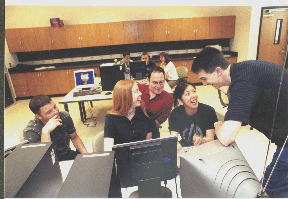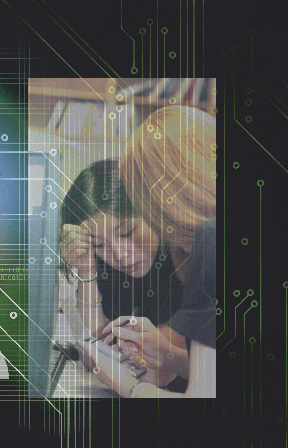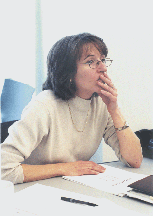Home, smart home
Computer science students are developing technology that we won’t be able to live without in the houses of tomorrow.
Home, smart home
Computer science students are developing technology that we won’t be able to live without in the houses of tomorrow.
 Lisa Burnell can visualize the home of the future. She walks in the door, speaks a few commands and magic happens. The stereo cues her favorite compact disc, the television clicks on her usual news station and the lights dim. All she has to do is relax, maybe put her feet up.
Lisa Burnell can visualize the home of the future. She walks in the door, speaks a few commands and magic happens. The stereo cues her favorite compact disc, the television clicks on her usual news station and the lights dim. All she has to do is relax, maybe put her feet up.
In the kitchen, the pantry is stocked because last week the computer reminded her what was running low and started a grocery list. For tonight, the oven is preheated and a couple of suggested recipes for the evening meal are printed out and ready to be prepared.
Welcome to the “smart” home of the future, where appliances and electronics are interconnected, voice-activated and programmed to remember entertainment, dining and lifestyle habits. Even George Jetson never had it this good.
“Basically, smart home technology adapts to you, not you to it,” says Burnell, an assistant professor of computer science. And it’s all coming in the not-too-distant future because of students like Burnell’s who are developing the technology. For the past two years, teams of two to four undergraduates in her Computer Science Senior Design class have devoted their senior year to writing programs for speech and graphic interface and intelligent learning modules to control household electronics and manage parts of a house.
The twist is that the project is simply too large for a single year. Or two. So each year, students reach a stopping point at the end of the spring semester and leave the work for the next class to resume. By project completion, dozens of students will have added pieces to the whole.
 “It’s great training for real life,” Burnell says. “Not only do they have to pick up and understand someone else’s project and read the programs, they also have to find solutions for problems they inherited and advance the project in a way that the next group can understand it.”
“It’s great training for real life,” Burnell says. “Not only do they have to pick up and understand someone else’s project and read the programs, they also have to find solutions for problems they inherited and advance the project in a way that the next group can understand it.”
In 2001, four groups developed the first two projects from scratch — the smart entertainment control system (SECS), and Morpheus, a program employing infrared signals, a speech interface and a limited learning function to identify users’ patterns. Accessed through a PDA or personal computer and a user can control a television from anywhere.
This year, two groups advanced the smart home project. One combined SECS and Morpheus to create the glorified house controller (GHC), which can operate multiple electronic devices, and reprogrammed the speech interface. Along the way, the team debugged the learning module, enabling it to remember more user patterns.
“Now, it will identify that you watch The Simpsons every week and will immediately turn the TV to the right channel when that program comes on,” says computer science senior Camille Wall, who got a head start on the class at shared research sessions at the University of Texas at Arlington last summer.
Another measurable step was an improved 3-D visual simulator, which helps students see how their technology will react in a house. “For example, as we develop sensors that detect movement in the house, they’ll be able to distinguish between a husband and wife,” Wall says. “And we can test to see how the software is supposed to work before the hardware is built.”
The second group began creating a smart home module for the kitchen. It uses a graphical user interface, such as a PDA, to help with inventory control, storage, reordering, recipe access and meal planning. The smart kitchen also has a learning function that will recall food preferences, allergies and ratings.
 “Let’s say your spouse calls and says the boss and his wife are coming home for dinner,” says computer science senior Joshua Chlapek. “You know he is on a salt-restrictive diet and she is lactose intolerant, so you can ask the smart kitchen to retrieve a menu plan that satisfies those constraints.”
“Let’s say your spouse calls and says the boss and his wife are coming home for dinner,” says computer science senior Joshua Chlapek. “You know he is on a salt-restrictive diet and she is lactose intolerant, so you can ask the smart kitchen to retrieve a menu plan that satisfies those constraints.”
As the computer science department grows, so will the smart home projects, Burnell says. It has already received a grant from TXU, which pays for two research assistants to study different methods for predicting inhabitant behavior, and another from the National Science Foundation, which funds two student researchers who will study how to fit the smart home projects under one umbrella system.
The NSF grant, shared with the UTA computer science and engineering department, also will be used to develop curriculum for advanced smart home courses.
The ultimate goal, Burnell says, is a collaborative technologies course that could be co-taught by TCU and UTA through distance education. “Obviously we’re interested in the cool engineering and a project leading to an actual product that can be taken to the marketplace. But even more important is the learning opportunity. These projects don’t have an easy solution.
“The teacher doesn’t have all the answers. But that’s part of the fun. The students get to figure it out.”

Your comments are welcome
Comments
Related Reading:
Campus News: Alma Matters
TCU’s Library Celebrates a Century
Uncover hidden gems of the academic hub, from vintage mechanics to modern masterpieces.
Campus News: Alma Matters
Infographic: TCU’s Shared Values
The Board of Trustees adopted four TCU values after considering input from more than 4,000 constituents.